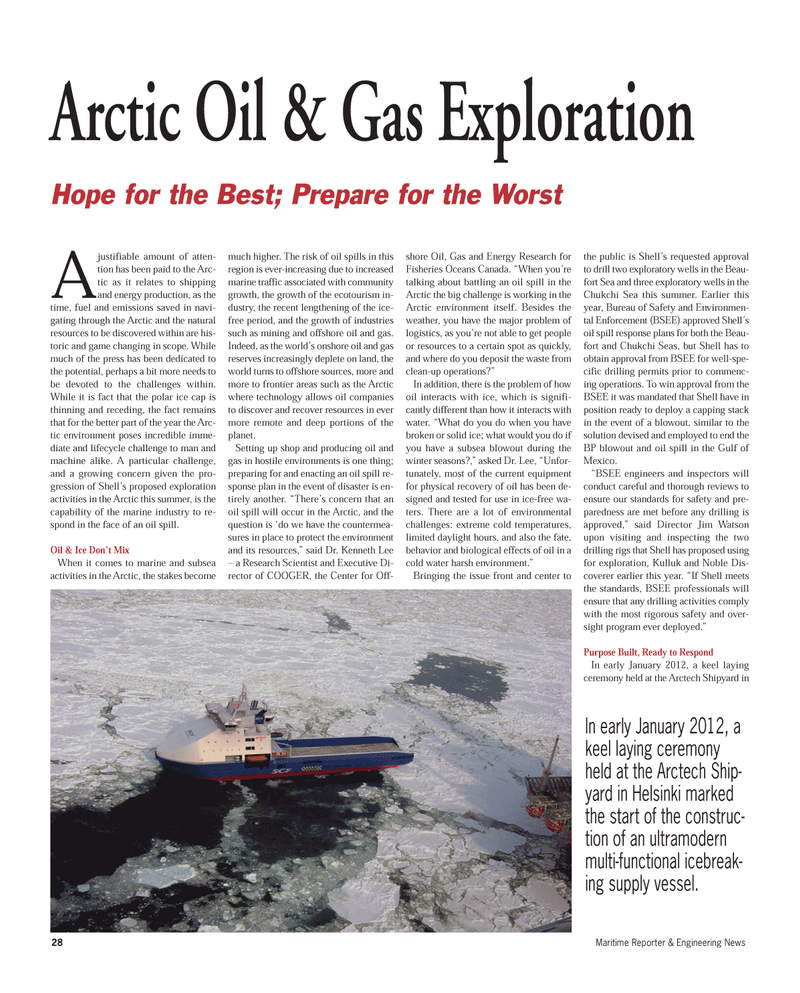
Page 28: of Maritime Reporter Magazine (July 2012)
Arctic Operations
Read this page in Pdf, Flash or Html5 edition of July 2012 Maritime Reporter Magazine
28Maritime Reporter & Engineering News Ajustifiable amount of atten- tion has been paid to the Arc- tic as it relates to shippingand energy production, as the time, fuel and emissions saved in navi- gating through the Arctic and the natural resources to be discovered within are his- toric and game changing in scope. While much of the press has been dedicated tothe potential, perhaps a bit more needs tobe devoted to the challenges within. While it is fact that the polar ice cap is thinning and receding, the fact remains that for the better part of the year the Arc- tic environment poses incredible imme- diate and lifecycle challenge to man and machine alike. A particular challenge, and a growing concern given the pro- gression of Shell?s proposed exploration activities in the Arctic this summer, is the capability of the marine industry to re-spond in the face of an oil spill. Oil & Ice Don?t MixWhen it comes to marine and subseaactivities in the Arctic, the stakes become much higher. The risk of oil spills in this region is ever-increasing due to increased marine traffic associated with community growth, the growth of the ecotourism in- dustry, the recent lengthening of the ice- free period, and the growth of industries such as mining and offshore oil and gas. Indeed, as the world?s onshore oil and gas reserves increasingly deplete on land, the world turns to offshore sources, more and more to frontier areas such as the Arctic where technology allows oil companies to discover and recover resources in ever more remote and deep portions of theplanet. Setting up shop and producing oil andgas in hostile environments is one thing; preparing for and enacting an oil spill re-sponse plan in the event of disaster is en- tirely another. ?There?s concern that an oil spill will occur in the Arctic, and the question is ?do we have the countermea- sures in place to protect the environment and its resources,? said Dr. Kenneth Lee ? a Research Scientist and Executive Di- rector of COOGER, the Center for Off- shore Oil, Gas and Energy Research for Fisheries Oceans Canada. ?When you?re talking about battling an oil spill in theArctic the big challenge is working in the Arctic environment itself. Besides the weather, you have the major problem of logistics, as you?re not able to get people or resources to a certain spot as quickly, and where do you deposit the waste from clean-up operations??In addition, there is the problem of how oil interacts with ice, which is signifi- cantly different than how it interacts with water. ?What do you do when you have broken or solid ice; what would you do if you have a subsea blowout during the winter seasons?,? asked Dr. Lee, ?Unfor- tunately, most of the current equipment for physical recovery of oil has been de- signed and tested for use in ice-free wa- ters. There are a lot of environmental challenges: extreme cold temperatures, limited daylight hours, and also the fate, behavior and biological effects of oil in a cold water harsh environment.? Bringing the issue front and center tothe public is Shell?s requested approval to drill two exploratory wells in the Beau- fort Sea and three exploratory wells in the Chukchi Sea this summer. Earlier this year, Bureau of Safety and Environmen- tal Enforcement (BSEE) approved Shell?s oil spill response plans for both the Beau-fort and Chukchi Seas, but Shell has to obtain approval from BSEE for well-spe- cific drilling permits prior to commenc- ing operations. To win approval from the BSEE it was mandated that Shell have in position ready to deploy a capping stack in the event of a blowout, similar to the solution devised and employed to end the BP blowout and oil spill in the Gulf of Mexico. ?BSEE engineers and inspectors willconduct careful and thorough reviews to ensure our standards for safety and pre-paredness are met before any drilling is approved,? said Director Jim Watson upon visiting and inspecting the two drilling rigs that Shell has proposed usingfor exploration, Kulluk and Noble Dis- coverer earlier this year. ?If Shell meets the standards, BSEE professionals willensure that any drilling activities comply with the most rigorous safety and over- sight program ever deployed.? Purpose Built, Ready to Respond In early January 2012, a keel laying ceremony held at the Arctech Shipyard in Arctic Oil & Gas Exploration Hope for the Best; Prepare for the Worst In early January 2012, akeel laying ceremony held at the Arctech Ship- yard in Helsinki marked the start of the construc- tion of an ultramodernmulti-functional icebreak- ing supply vessel. MR#7 (26-33):MR Template 7/9/2012 9:41 AM Page 28

 27
27

 29
29
